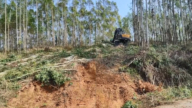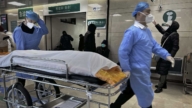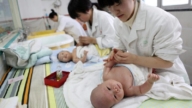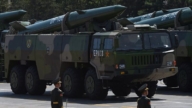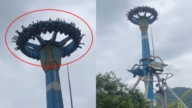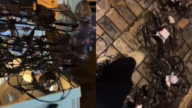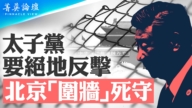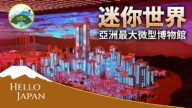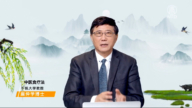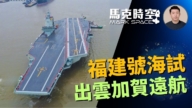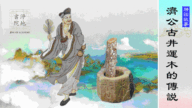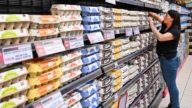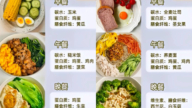【新唐人2011年7月5日讯】中国已成为世界最大的废塑胶市场。中国大陆海关统计,光是去年(2010年)1月就进口了55万吨废弃塑胶。有媒体报导,多年来,中国地方当局对于污水处理厂和环保产业园区等政策,执行不力,造成今天中国环境污染的问题越来越严重。
六月底《南方都巿报》报导,废塑胶回收加工业近年来不但在河北省快速扩张,更蔓延到浙江、江苏、湖北武汉、山东、河南安阳等地。
以河北省廊坊市文安县为例,当地芦各庄里一个村民对《南都》记者说,当地废塑胶回收加工产业是从上世纪80年代末开始的。一开始只有少数村民骑着自行车,从天津、北京载一些不要钱的废弃塑胶回来,分类后再拿去卖,赚个差价。因为好赚钱又不花什么成本,于是90年代末,农民们开始以农用车拖回大量塑胶垃圾加工。而最近四、五年村民们发现“洋垃圾”品质比国内的垃圾好,因此反而愿意付钱向外国人“抢货”。
至于大量的塑胶回收物到哪儿去了?报导说,加工出产的塑胶颗料或成品销往全国各地。从塑胶袋、果篮、脸盆、塑胶碗、软门帘到电视机、洗衣机、冰箱外壳等都能做。
2004年,高压聚乙烯一吨约7000块钱人民币,而回收利用后的同类再生颗粒,平均价格一吨只要3800块钱,中间利差达3200块钱。加上中国对塑胶原料的旺盛需求,全中国塑胶制品产量从开放初的104万吨,到2007年已达到3600万吨。
不过废塑胶回收加工业是一种高污染产业,随着各家厂房一天天扩建,大量取土把农田挖成了大沟小壑。这些大沟槽,变成村民们用来倾倒回收过程产生的大量垃圾。
此外,回收废塑胶,一般会先集中放进水池一天,第二天再放进另一个水池浸一天,或直接投入火碱、硫酸清洗。报导说,这些含有大量污染物的清洗用水,超过九成被直接排入当地水沟、河流或田里。过去村内的水井打到100公尺就有好水,现在要打到300公尺才能喝,有钱一点的人早就不敢喝井水了,改买桶装水。
报导还说,虽然2007年,地方政府建成文安县第一座污水处理厂,每天处理污水能力达1000 吨。不过当地村民说:这座健源污水处理厂,只有上级领导视察时才会开机运转一下。目前,污水厂大门紧闭,长满荒草。污水厂外大沟里只看到粉红色的污水,根本没有处理过。
另外,由北京“第五建筑工程有限公司”投资的文安县“东都环保产业园”,2008年建成投产,并获得环保部核发的废物进口许可证,原本打算建成北方最大的垃圾处理基地。不过《南都》记者发现,厂区内一座座工厂几乎没什么人。留守人员说,因为厂房租金太高,小工厂不敢进来,开工不足。目前只有18家企业进驻,园区内建成的污水处理厂已停转几年了。
新唐人记者曾耀贤、李月综合报导。
Severe Pollution from Plastic Recycling
China’s plastic recycling is the largest worldwide.
In Jan 2010, China imported 550,000 tons
of plastic waste to recycle. Media reports however
that local governments fail to follow policies
on waste recycling, and pollution is rather serious.
Southern Metropolis Daily (SMD) reported
that the plastic recycling industry has grown
in Hebei, Zhejiang, Jiangsu and other places.
The report said in Wenan County of Hubei,
plastic recycling started in the 1980s.
A villager told SMD that in the beginning
a few villagers collected plastics
in Tianjin and Beijing free of charge,
and then have reclassified and sold them.
In the 1990s more villagers joined in.
They trucked in large amounts of plastic waste.
Recently they saw that foreign plastic waste
is of better quality, so they are willing to pay
to get foreign waste.
Where did the recycled plastic go?
They are made into plastic goods all over China,
including plastic bags, fruit baskets, bowls,
and the covers of television and washing machines.
In 2004, low density polyethylene (LDPE)
was priced at RMB7,000/ton, but the equivalent
made from recycled plastic was only RMB3,800/ton.
China has a large demand for plastic,
which rose from 1 million tons in the 1980s
to 36 million tons in 2007.
The plastic recycling industry is highly polluting.
To build more and larger recycling factories,
people took top soils from the crop field.
And field ditches are used to dump the waste.
Recycled plastics must be soaked in water tanks
for two days, or washed in solution with alkaline
and sulfuric acid. The highly toxic liquid
produced in the process is mostly dumped
into the local waste system, rivers and fields.
In the past, well water was safe at 100m deep,
but now wells have to reach 300m to be safe.
Rich villagers all drink bottled water.
A SMD report said, in 2007 Wenan County built
the first waste water treatment plant,
but its treatment capacity is low.
Villagers said the plant only operates
when higher-level officials come to inspect.
Now the plant’s gate is closed and next to it
pink waste water “beautifies" the scenery.
Wenan County built an “environmental garden"
in 2008 for environmental protection factories,
and received permit to import foreign waste.
The garden is intended to be the largest
waste processing center in Northern China.
The report said the garden is pretty empty now.
The rent is too high for factories to move in.
Only 18 factories entered the garden,
and waste water treatment has stopped operating.
NTD reporters Zeng Yaoxian and Li Yue.



